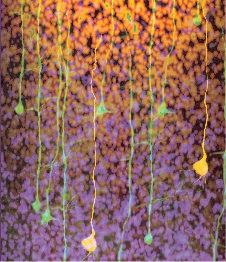PUBLICATIONS

Finkbeiner S. (2010) Bridging the Valley of Death of therapeutics for neurodegeneration. Nat. Med. 16:1227–1232.
Barmada SJ, Skibinski G, Korb E, Rao EJ, Wu JY, Finkbeiner S. (2010) Cytoplasmic mislocalization of TDP43 is toxic to neurons and is enhanced by a mutation associated with familial ALS. J. Neurosci. 13:639–649.
Tsvetkov AS, Miller J, Arrasate M, Wong JS, Pleiss MA, Finkbeiner S. (2010) A small-molecule scaffold induces autophagy in primary neurons and protects against toxicity in a Huntington’s disease model. Proc. Natl. Acad. Sci. U. S. A. 107:16982–16987.
Miller J, Arrasate M, Mitra S, Masliah E, Finkbeiner S. (2010) Quantitative relationships between huntingtin levels, polyglutamine length, inclusion body formation, and neuronal death provide novel insight into Huntingotn’s disease molecular pathogenesis. J. Neurosci. 30:10541–10550.
Daub A, Sharma P, Finkbeiner S. (2009) High-content screening of primary neurons: Ready for prime time. Curr. Opin. Neurobiol. 19:537–543.
Gu X, Greiner ER, Mishra R, Kodali R, Osmand A, Finkbeiner S, Steffan JS, Thompson LM, Wetzel R, and Yang XW. (2009) Ser13 and Ser16 are critical determinants of full-length human mutant huntingtin induced disease pathogenesis in HD mice. Neuron 64:828–840.
Thompson LM, Aiken CT, Agrawal N, Kaltenbach LS, Illes K, Khoshnan A, Martinez-Vincente M, Arrasate M, O’Rourke JG, Lukacsovich T, Zhu Y-Z, Lau AL, Massey A, Hayden MR, Zeitlin SO, Finkbeiner S, Huang L, Lo DC, Patterson PH, Cuervo AM, Marsh JL, and Steffan JS. (2009) The IKK phosphorylates huntingtin and targets it for degradation by the proteasome and lysosome. J. Cell Bio. 187:1083–1099.
Mitra S, Tsvetkov A, Finkbeiner S. (2009) Single neuron ubiquitin-proteasome dynamics accompanying inclusion body formation in Huntington’s disease. J. Biol. Chem. 284:4398–4403.
Montie HL, Cho MS, Holder L, Liu Y, Tsvetkov AS, Finkbeiner S, Merry DE. (2009) Cytoplasmic retention of polyglutamine-expanded androgen receptor ameliorates disease via autophagy in a mouse model of spinal and bulbar muscular atrophy. Hum. Mol. Gen. 18:1937–1950.
Tsvetkov A, Mitra S, Finkbeiner S. (2009) Protein turnover differences between neurons and other cells. Autophagy 5:1–3.
Legleither J, Lotz GP, Miller J, Ko J, Ng C, Williams GL, Finkbeiner S, Patterson PH, Muchowski PJ. (2009) Monoclonal antibodies recognize distinct conformational epitopes formed by polyglutamine in a mutant huntingtin fragment. J. Biol. Chem. 284:21647–21658.
Wacker JL, Huang SY, Steele AD, Aron R, Lotz GP, Nguyen Q, Giorgini F, Roberson ED, Lindquist S, Masliah E, Muchowski PJ. (2009) Loss of Hsp70 exacerbates pathogenesis but not levels of fibrillar aggregates in a mouse model of Huntington’s disease. J. Neurosci. 29:9104–9114.
Mitra S, Finkbeiner S. (2008) The ubiquitin-proteasome pathway in Huntington’s disease. ScientificWorldJournal 8:421–433.
Palop JJ, Chin J, Twin M, Bien-Ly N, Yoo J, Yu G-Q, Kreitzer A, Wang J, Finkbeiner S, Noebels JL, Mucke L. (2007) Aberrant excitatory neuronal activity and compensatory remodeling of hippocampal circuits in mouse models of Alzheimer’s disease. Neuron 55:697–711.
Finkbeiner S, Cuervo AM, Morimoto RI, Muchowski PJ. (2006) Disease-modifying pathways in neurodegeneration. J. Neurosci. 26:10349–10357.
Beal FM, Bossy-Wetzel E, Finkbeiner S, Fiskum G, Glasson B, Johnson C, Khachaturian ZS, Lee VMY, Nicholls D, Reddy H, Reynolds I, Teplow DB, Thal LJ, Trojanowski JQ, Walsh DM, Wetzel R, Wexler NS, Young AB, Bain L. (2006) Common threads in neurodegenerative disorders of aging. Alzheimers Dement. 2:322–326.
Arrasate M, Finkbeiner S. (2005) Automated microscope system for determining factors that predict neuronal fate. Proc. Natl. Acad. Sci. U.S.A. 102:3840–3845.
Peters-Libeu C, Newhouse Y, Krishnan P, Cheung K, Brooks E, Weisgraber K, Finkbeiner S. (2005) Crystallization and diffraction properties of the Fab fragment of 3B5H10—an antibody specific for disease-causing polyglutamine stretches. Acta Crystallogr. Sect. F Struct. Biol. Cryst. Commun. 61:1065–1068.
Arrasate M, Mitra S, Schweitzer ES, Segal MR, Finkbeiner S. (2004) Inclusion body formation reduces levels of mutant huntingtin and the risk of neuronal death. Nature 431:805–810. See also accompanying News and Views: Orr HT. (2004) Neuron protection agency. Nature 431:747–748.
Brooks L, Arrasate, M, Cheung K, Finkbeiner S. (2004) Using antibodies to analyze polyglutamine stretches. In: Methods in Molecular Biology: Triplet Repeat Protocols. Ed: Kohwi Y. Totowa: Humana Press. pp. 103–127.